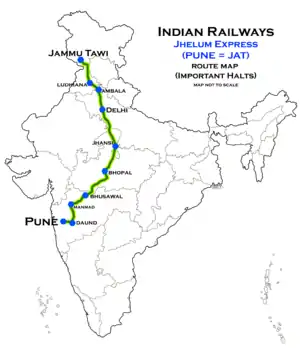| Overview | |||||
|---|---|---|---|---|---|
| Service type | Express | ||||
| First service | 1 April 1979 | ||||
| Current operator(s) | Central Railways | ||||
| Route | |||||
| Termini | Pune (PUNE) Jammu Tawi (JAT) | ||||
| Stops | 63 | ||||
| Distance travelled | 2,177 km (1,353 mi) | ||||
| Average journey time | 40 hrs 50 minutes | ||||
| Service frequency | Daily | ||||
| Train number(s) | 11077 / 11078 | ||||
| On-board services | |||||
| Class(es) | AC 2 Tier, AC 3 Tier, Sleeper Class, General Unreserved | ||||
| Seating arrangements | Yes | ||||
| Sleeping arrangements | Yes | ||||
| Catering facilities | Available | ||||
| Baggage facilities | Available | ||||
| Other facilities | Below the seats | ||||
| Technical | |||||
| Rolling stock | ICF coach | ||||
| Track gauge | 1,676 mm (5 ft 6 in) broad gauge | ||||
| Operating speed | 54.57 km/h (34 mph) average including halts | ||||
| |||||
The 11077 / 11078 Jhelum Express is a daily train on the Indian Railways. It runs from Pune, the cultural capital of Maharashtra, to Jammu Tawi, the winter capital of Jammu and Kashmir, in North India.
The train is strategically important, as it connects the headquarters of the Southern Command of the Indian Army, Pune, with an important border city. And Military Reserved compartment.
History
The Jhelum Express is one of the oldest trains originating from Pune. Started in 1979,[1] it was the first train connecting Pune to the capital city of New Delhi. The train was initially started for the military.
Number and nomenclature
Although it is River Tawi, a tributary of River Chenab which flows through the city of Jammu, the train is named after the Jhelum, often confused with the river is also a city on the banks of the river it's named after. This nomenclature was adopted at the behest of S. Prakash Singh Ghai, a partner at 'Ghai Brothers', a pioneer firm of railway contractors around the time the train first hit the tracks. The Ghai family hailed from the Pinanwal, a village in district Jhelum and settled in Pune post-partition. The Up train, Pune–Jammu Tawi, has the number 11077,[2] while the Down train, Jammu Tawi–Pune, is numbered 11078.
Route and halts
The 11077 / 11078 Jhelum Express runs from Pune Junction via Daund Junction, Manmad, Bhusawal, Khandwa, Itarsi Junction, Bhopal Junction, Bina, Jhansi Junction, Gwalior, Agra Cantonment, Mathura Junction, New Delhi, Narela, Sonipat Junction, Panipat, Kurukshetra Junction, Ambala Cantonment, Sirhind, Ludhiana, Jalandhar Cantonment, Pathankot Cantonment, Kathua to Jammu Tawi.
Future prospects
With the doubling and electrification of the Daund–Manmad section and the Jalandhar–Pathankot–Jammu Tawi section, the Jhelum Express is expected to run faster, with comparatively less running time. Moreover, with the completion of Katra–Banihal section in 2018 December, the train is also expected to be extended to Srinagar, linking the important army setups in Kashmir with Northern Command headquarters in Udhampur and Southern Command headquarters in Pune. There is strong demand to extend this train up to Miraj junction which will facilitate military personnel and tourists from Sangli, Satara and Kolhapur districts.
Traction
Initially it was hauled by Pune-based twin WDM-3A or a single WDP-4 from Pune Junction till Manmad Junction after which it was hauled by a Bhusawal-based WAP-4 or Ghaziabad-based WAP-7 or WAP-4 until Jalandhar after which it was hauled by a Ludhiana-based WDM-3A till Jammu Tawi.
With the electrification of the Jalandhar–Pathankot-Jammu Tawi section in 2014 and Pune–Daund-Manmad section in 2016, it is hauled from end-to-end by a Ghaziabad- based WAP-7 locomotive.
Gallery
 11077 Jhelum Express – AC 2 tier coach
11077 Jhelum Express – AC 2 tier coach 11077 Jhelum Express at Pune Junction
11077 Jhelum Express at Pune Junction 11077 Jhelum Express – Sleeper coach
11077 Jhelum Express – Sleeper coach
See also
References
- ↑ "Central Railway / Indian Railways Portal".
- ↑ "Jhelum Express 11077 Time Table". cleartrip.com. Archived from the original on 23 September 2015. Retrieved 30 August 2016.
